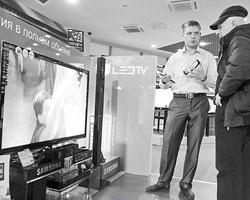The last decades of TV energizes shattered taboos energy abolition of social rules and regulations. Now the race is over – surprise the viewer nothing else. Everything, that is, all boring. What to do?
The last decades of TV energizes destroyed taboos energy abolition of social rules and regulations. Now the race is over – surprise the viewer nothing else.
«At the forefront the problem of codecs – video compression algorithm. And then Russia has a strong foundation »
Violence, perversion, thrall others suffering and humiliation – it was that boring. There is a small nest egg in the form of cannibalism, but we’ll get it soon.
In general, the metamorphosis is finished, the end of formats held.
What about the industry? How to keep the viewer, which is already half fled to the Internet? Answer – greater involvement by technical means. TV picture should be increased in size and bring it closer to the real clarity to human vision. That’s when the “Fear Factor” and “Dom-2″ sparkle with new colors.
This is why we moved to HD (1920×1080 pixels), and is now ready to increase the number of pixels on the screen four times and go to Format 4K (3840h2160).
But 4K – it does not finish the race, the real physiological limit – it is four times more – 8K (7680h4320). 8K – a 33 million points – the end of the race.
A bit of technical information. The resolution of the human eye is about 1 arc minute, that is, at this value, we do not notice that the screen is composed of pixels – pixels.
Now, that does not distinguish individual pixels, we are forced to watch TV while from it at a considerable distance (about 3 screen height). Because of this, the image itself occupies only 30 ° of our field of view, all the peripheral vision is not involved in viewing. Such is the case with HD.
 We are waiting for TVs with a diagonal of 80 inches, with a resolution of 33 million pixels and features 3D without glasses (Photo: Alexey Filippov / TASS)
|
When you go to 8K we can be on the TV at a distance of 0.75 height of the screen and do not distinguish between individual points. Image Takes 100 ° and will include peripheral areas of our vision.
That is, we will sit very close to the TV? No, the TV will be huge. We will sit on the same couch, and TV will take the wall opposite. We’ll see the same picture clear as the surrounding reality.
Then all in the development of technologies 8K left Japanese. Research company Astro Design has created a compact 8K camera and recorder and even boxing for underwater filming in the 8K. Recently, a group of leading Russian specialists were invited to the laboratory Astro Design, and I was able to talk with them – yes, indeed, the underwater shooting 8K on-screen with a diagonal of 100 inches provide full involvement.
The interest of the Japanese to Russian developers do not accidental. Of course, we can not do better than the Japanese camera, but the camera – only half the task. 8K signal – a gigantic flow of information, transfer it using conventional techniques impossible. Comes to the fore the problem of codecs – video compression algorithm. And then Russia has a strong foundation.
Studies in video compression are conducted in Moscow institutes and universities, but would like to separately mention Tomsk. Since 2012 in Tomsk carried out test broadcasting in digital television standards of the second generation DVB-T2, the company Elecard on the market of video is about the same as Kaspersky antivirus on the market.Tomsk State University for many years engaged in the problems of compression, in late December 2014 University of another protected thesis on the new standard H.265 / HEVC – another step towards solving the problem of signal transmission 8K. In short, the Russian mathematicians involved in the technological race on equal terms.
For full engagement need to add to the image volume. And it’s already been done. Last year, Sharp demonstrated a prototype 8K display with 3D without glasses, but again Tomsk company Triaxes leads the only pop-software market for such screens. Toshiba presented a new technology TVs volume that uses liquid crystal microlenses with variable refractive index gradient.
So, we are waiting for TVs with a diagonal of 80 inches, with a resolution of 33 million pixels and features 3D without glasses. By 2020, they will be in our apartments.
According to the “box” will go all the same, but we will be even more strongly involved.
Here you can put a full stop, but the question arises .
8K – cool, but sooner or later become commonplace and it is. Where next move television because television show formats are not progressing? The answer to the question – even greater involvement by technical means. In 2030, plans to launch a spatial three-dimensional television, otherwise known as holography.
I will try to keep you informed.
No comments:
Post a Comment